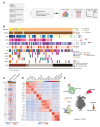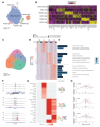This is a preprint.
Single-cell epigenetic profiling reveals an interferon response-high program associated with BAP1 deficiency in kidney cancer
- PMID: 39605676
- PMCID: PMC11601305
- DOI: 10.1101/2024.11.15.623837
Single-cell epigenetic profiling reveals an interferon response-high program associated with BAP1 deficiency in kidney cancer
Abstract
Renal cell carcinoma (RCC) is characterized by recurrent somatic mutations in epigenetic regulators, which stratify patients into clinically significant subgroups with distinct prognoses and treatment responses. However, the cell type-specific epigenetic landscape of RCC-broadly and in the context of these mutations-is incompletely understood. To investigate these open questions, we integrated single nucleus ATAC sequencing data from RCC tumors across four independent cohorts. In clear cell RCC tumors, we identified four shared malignant epigenetic programs related to angiogenesis, proximal tubule-like features, interferon (IFN) signaling, and one that lacked distinct genomic regions with increased accessibility. Among the mutated epigenetic regulators, BAP1 mutation exhibited the most significant impact on chromatin accessibility in tumor cells, and the associated epigenetic changes were linked to IFN response. We identify multiple potential sources of elevated IFN signaling in these lesions, such as increased immune infiltration and increased accessibility and expression of an IFN-associated ERV, ERV3-16A3_LTR. We find that the expression of ERV3-16A3_LTR may itself be a negative prognostic biomarker in ccRCC. Our findings highlight the convergence of malignant epigenetic programs across ccRCC tumors and suggest that BAP1 loss, potentially through ERV3-16A3_LTR dysregulation, is associated with an IFN response-high epigenetic program.
Figures





References
-
- Guo G. et al. Frequent mutations of genes encoding ubiquitin-mediated proteolysis pathway components in clear cell renal cell carcinoma. Nat. Genet. 44, 17–19 (2011). - PubMed
Publication types
Grants and funding
LinkOut - more resources
Full Text Sources
